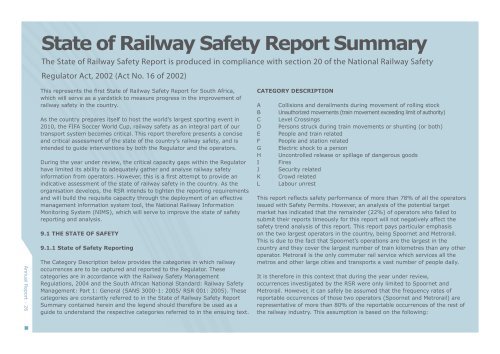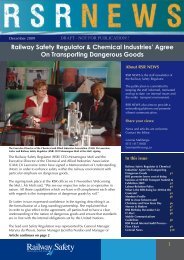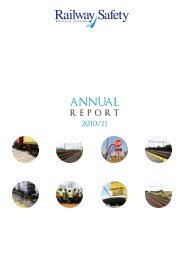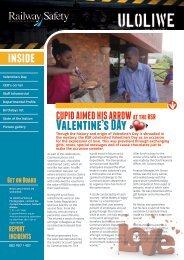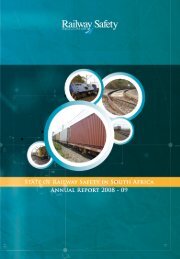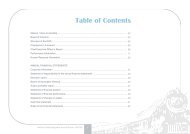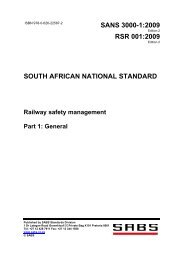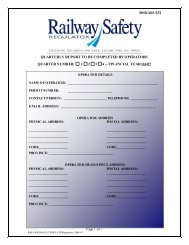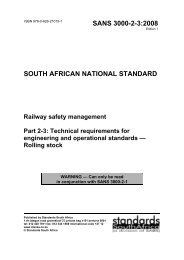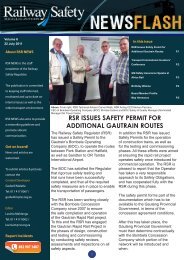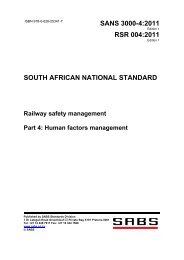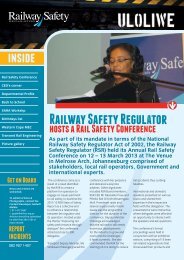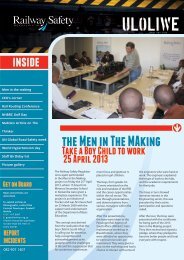ANNUAL REPORT 2005/2006 - Railway Safety Regulator
ANNUAL REPORT 2005/2006 - Railway Safety Regulator
ANNUAL REPORT 2005/2006 - Railway Safety Regulator
- No tags were found...
Create successful ePaper yourself
Turn your PDF publications into a flip-book with our unique Google optimized e-Paper software.
State of <strong>Railway</strong> <strong>Safety</strong> Report SummaryThe State of <strong>Railway</strong> <strong>Safety</strong> Report is produced in compliance with section 20 of the National <strong>Railway</strong> <strong>Safety</strong><strong>Regulator</strong> Act, 2002 (Act No. 16 of 2002)Annual Report - 26This represents the first State of <strong>Railway</strong> <strong>Safety</strong> Report for South Africa,which will serve as a yardstick to measure progress in the improvement ofrailway safety in the country.As the country prepares itself to host the world’s largest sporting event in2010, the FIFA Soccer World Cup, railway safety as an integral part of ourtransport system becomes critical. This report therefore presents a conciseand critical assessment of the state of the country’s railway safety, and isintended to guide interventions by both the <strong>Regulator</strong> and the operators.During the year under review, the critical capacity gaps within the <strong>Regulator</strong>have limited its ability to adequately gather and analyse railway safetyinformation from operators. However, this is a first attempt to provide anindicative assessment of the state of railway safety in the country. As theorganisation develops, the RSR intends to tighten the reporting requirementsand will build the requisite capacity through the deployment of an effectivemanagement information system tool, the National <strong>Railway</strong> InformationMonitoring System (NIMS), which will serve to improve the state of safetyreporting and analysis.9.1 THE STATE OF SAFETY9.1.1 State of <strong>Safety</strong> ReportingThe Category Description below provides the categories in which railwayoccurrences are to be captured and reported to the <strong>Regulator</strong>. Thesecategories are in accordance with the <strong>Railway</strong> <strong>Safety</strong> ManagementRegulations, 2004 and the South African National Standard: <strong>Railway</strong> <strong>Safety</strong>Management: Part 1: General (SANS 3000-1: <strong>2005</strong>/ RSR 001: <strong>2005</strong>). Thesecategories are constantly referred to in the State of <strong>Railway</strong> <strong>Safety</strong> ReportSummary contained herein and the legend should therefore be used as aguide to understand the respective categories referred to in the ensuing text.CATEGORY DESCRIPTIONABCDEFGHIJKLCollisions and derailments during movement of rolling stockUnauthorized movements (train movement exceeding limit of authority)Level CrossingsPersons struck during train movements or shunting (or both)People and train relatedPeople and station relatedElectric shock to a personUncontrolled release or spillage of dangerous goodsFiresSecurity relatedCrowd relatedLabour unrestThis report reflects safety performance of more than 78% of all the operatorsissued with <strong>Safety</strong> Permits. However, an analysis of the potential targetmarket has indicated that the remainder (22%) of operators who failed tosubmit their reports timeously for this report will not negatively affect thesafety trend analysis of this report. This report pays particular emphasison the two largest operators in the country, being Spoornet and Metrorail.This is due to the fact that Spoornet’s operations are the largest in thecountry and they cover the largest number of train kilometres than any otheroperator. Metrorail is the only commuter rail service which services all themetros and other large cities and transports a vast number of people daily.It is therefore in this context that during the year under review,occurrences investigated by the RSR were only limited to Spoornet andMetrorail. However, it can safely be assumed that the frequency rates ofreportable occurrences of those two operators (Spoornet and Metrorail) arerepresentative of more than 80% of the reportable occurrences of the rest ofthe railway industry. This assumption is based on the following:


